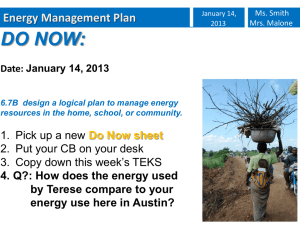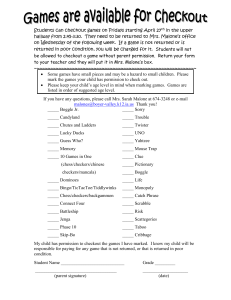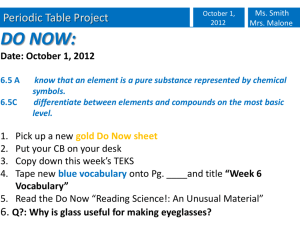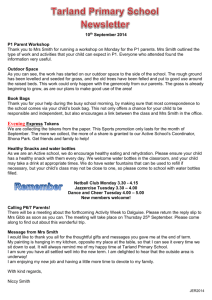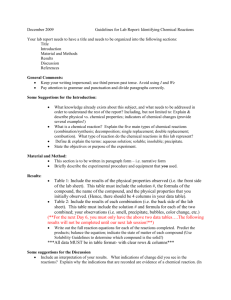Chemical changes
advertisement
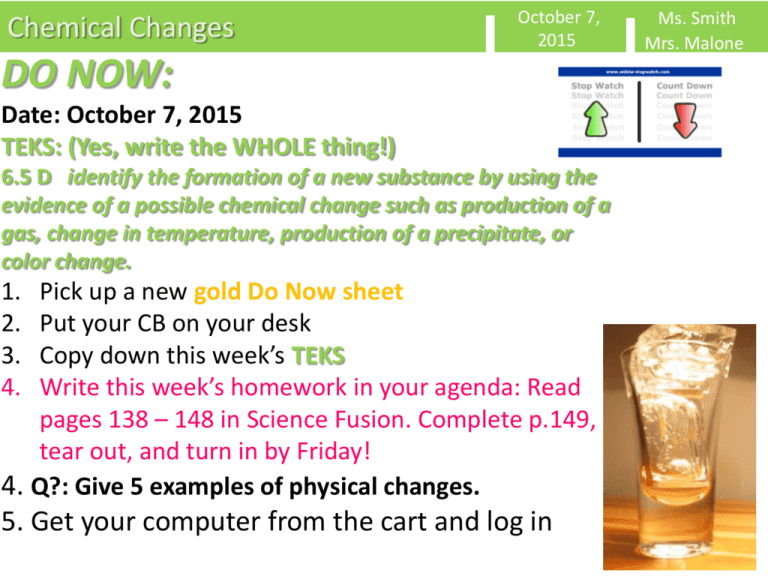
Chemical Changes October 7, 2015 DO NOW: Date: October 7, 2015 TEKS: (Yes, write the WHOLE thing!) 6.5 D identify the formation of a new substance by using the evidence of a possible chemical change such as production of a gas, change in temperature, production of a precipitate, or color change. 1. 2. 3. 4. Pick up a new gold Do Now sheet Put your CB on your desk Copy down this week’s TEKS Write this week’s homework in your agenda: Read pages 138 – 148 in Science Fusion. Complete p.149, tear out, and turn in by Friday! 4. Q?: Give 5 examples of physical changes. 5. Get your computer from the cart and log in Ms. Smith Mrs. Malone • Homework: Read pages 138 – 148 in Science Fusion. Complete p.149, tear out, and turn in by Friday! • Announcements: – Tutorials Tuesday – Fresh Start! It’s a new 6 week marking period • • • • PhET Simulation (Google Chrome!) http://phet.colorado.edu/en/simulation/build-a-molecule Click on the green “Run Now” box Wait for the simulator to load and press “Run” If you get a security warning at the bottom of the screen, press “Keep” • Click the downloaded program in the bottom left corner of the browser. If you get a Java update message, just press “Later” • Press “Run” and explore the program! Be sure to fill out your paper as you explore. – – – – Make molecules and drag them to your collection. Click “Refill Kit” if you run out of atoms and need more. Click the yellow arrow if you need a different kind of atom. Move onto the next collection after you complete your student sheet for collection 1. – Complete Collections 1 – 4 Chemical Changes DO NOW: Date: October 6, 2015 6.5 D identify the formation of a new substance by using the evidence of a possible chemical change such as production of a gas, change in temperature, production of a precipitate, or color change. 1. Put your CB on your desk 2. Get your computer and turn it on. Answer the Do Now question while your computer loads. 3. Q?: What are compounds made of? October 6, 2015 Ms. Smith Mrs. Malone • Homework: Read pages 138 – 148 in Science Fusion. Complete p.149, tear out, and turn in by Friday! Chemical Changes October 6, 2014 Ms. Smith Mrs. Malone Chemical changes occur when matter has changed into a new substance through a chemical reaction. Signs of a chemical reaction include: color change gas produced (bubbling, fizzing, smoke) solid precipitate temperature change exothermic = hot endothermic = cold : Demonstration • Copper (II) Sulfate + Ammonia • Did a chemical reaction occur? • What was the sign of a chemical change? Chemical Changes Presentation • • • • • • www.ohenryscience6.weebly.com Click on Handouts Download the file Press F5 to make the presentation full screen Complete your Cornell Notes on your own Finished early? Continue working on yesterday’s PhET simulation! Chemical Changes DO NOW: Date: October 7 - 8, 2015 6.5 D identify the formation of a new substance by using the evidence of a possible chemical change such as production of a gas, change in temperature, production of a precipitate, or color change. 1. Things are going to be messy today. Make sure your backpack is UNDER your table 2. Q?: What signs of a chemical reaction do you observe in the animation? Pictured: A gummy bear (made of glucose) reacts with potassium chlorate October 7 - 8, 2015 Ms. Smith Mrs. Malone • Homework: Read pages 138 – 148 in Science Fusion. Complete p.149, tear out, and turn in by Friday! Group Member Roles October 7 - 8, 2014 Ms. Smith Mrs. Malone Green - Materials Manager • Obtains and returns all lab materials Yellow – Safety/Clean-up Manager • Enforces all safety rules (Goggles and Glass!!) Blue - Activity Director • Reads directions to the group • Keeps group on-task Red - Data Manager • Ensures all group members have lab data : Chemical Changes October 6, 2014 Ms. Smith Mrs. Malone Chemical changes occur when matter has changed into a new substance through a chemical reaction. Signs of a chemical reaction include: color change gas produced (bubbling, fizzing, smoke) solid precipitate temperature change exothermic = hot endothermic = cold : Evidence of a chemical change. 1. Formation of a gas Bubbles, fizz, or smoke form when a new substance is produced. Listen for the sound of bubbles popping! Watch out! Shaking something to create bubbles and opening a can of pressurized soda to release the CO2 are not chemical changes! Chemical Change 2. Color Change ◦ The product is a new color that was not there before ◦ Watch out! Adding a dye (like paint or food coloring) to change the color of something is NOT a chemical change Chemical Change 3. Temperature Change • The new substance is hotter (exothermic) or colder (endothermic) than the substances that formed it • Watch out! Sometimes substances change temperature because YOU alter them, not from a chemical reaction! – Heating a substance (microwave, hot plate, flame, etc.) – Cooling a substance (with ice, in the refrigerator, in the freezer, etc.) Chemical Change 4. Formation of a Precipitate • A precipitate forms when a substance comes out of solution and forms a new solid that wasn’t there before • Watch out! Freezing is a physical change, not a chemical change! Universal Indicator • A chemical change occurs when universal indicator is added to acids and bases – Universal indicator is an indicator, because it contains molecules that change color when an acid or base is added to them. Compare your samples to the key. Mystery Powders Steps for Success • Each powder has its own numbered column. Use the index cards to keep the powders separated when adding to the wells • Describe all 6 powders BEFORE reacting (color, texture, state of matter) • Describe all 4 liquids BEFORE reacting (color, smell, state of matter) • Do NOT touch the dropper bottle tips to the powders or you will contaminate the entire bottle!! • GOGGLES ON AT ALL TIMES. MICROCHEMISTRY PLATES WILL SPLASH WHEN RINSED! Mystery Powders Analysis and Conclusion • Fill in your data table – no blanks! Write “No reaction” if there was no reaction • Answer the analysis questions with your group and support your answers with your data • Write a conclusion for Mystery Powders using Page 3 Lab Resources – Lab Conclusion Guide from your interactive notebook (comp book) • TURN IN YOUR LAB REPORT PAPER today for a grade Chemical Change • A chemical change occurred when universal indicator was added to cream of tartar and laundry detergent. – Universal indicator is an indicator, because it contains molecules that change color when an acid or base is added to them. – Cream of tartar is an acid, so it gave particles to the indicator, making it turn from purple to red. – Laundry detergent is a base, so it took particles from the indicator, making it turn from red back to purple. Is It a Chemical Change? Whiteboard Review • Write YES if the example shows signs of a chemical change • Write the sign(s) that prove that the example is a chemical change • Write NO if the example if not a chemical change • Explain why it is a physical change and not a chemical change Is it a chemical change? A forest fire destroys acres of land. There is a lot of smoke, and the trees turn to charcoal. ANSWER: EVIDENCE: YES - color change, - temperature change Is it a chemical change? When making hot cocoa, clear water turns brown when you mix the cocoa in. ANSWER: No (the water is turning brown because the cocoa is brown) Is it a chemical change? An old wheelbarrow is left out in the rain and rusts. ANSWER: Yes EVIDENCE: Color change, precipitate forming (rust) Is it a chemical change? On a hot day, water forms on the outside of a cold glass of water. ANSWER: No (No new substance is forming) Is it a chemical change? Ice cream melts after it falls on the ground. ANSWER: No (No new substance is forming) Is it a chemical change? A raw egg gets cooked. ANSWER: Yes EVIDENCE: Color change Is it a chemical change? When Alka Seltzer is dropped into water it fizzes. ANSWER: Yes EVIDENCE: gas formation Is it a chemical change? Crayons change white paper to red. ANSWER: No (The paper is turning red because the crayon is red.) Is it a chemical change? Soda fizzes, and bubbles rise as you pour it in a glass. ANSWER: No (The bubbles were already there, just under pressure in the bottle.) Is it a chemical change? When you crack a glow stick, hydrogen peroxide mix with other chemicals, causing it to glow and warm up. ANSWER: EVIDENCE: Yes - color change - temperature change Chemical Changes DO NOW: Date: October 9, 2015 6.5 D identify the formation of a new substance by using the evidence of a possible chemical change such as production of a gas, change in temperature, production of a precipitate, or color change. 1. Turn in your homework! 2. Get out purple Do Now sheet – due today! 3. Q?: What are the 4 signs of a chemical reaction? October 9, 2015 Ms. Smith Mrs. Malone Reminders: – Did you turn in your Chemistry in the Kitchen Homework? To Do: Friday, October 10th 1. Complete “Mystery Powders” initial observations, data table, analysis questions, and conclusion (using page 3 lab conclusion guide) and TURN IT IN today. 2. Complete PhET Molecules simulation and Chemical Changes Notes 3. Check your science journal for completion. Use my sample comp book as a guide! My journal has 29 complete pages. Yours should too!
